engine PONTIAC FIREBIRD 1995 Owners Manual
[x] Cancel search | Manufacturer: PONTIAC, Model Year: 1995, Model line: FIREBIRD, Model: PONTIAC FIREBIRD 1995Pages: 386, PDF Size: 19.66 MB
Page 2 of 386
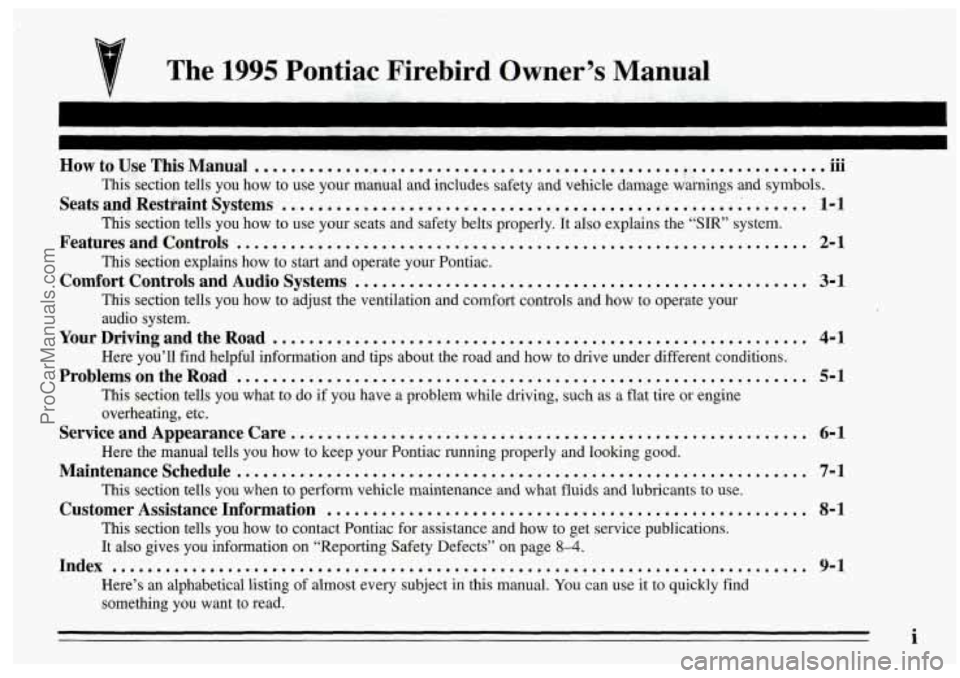
The 1995 Pontiac Firebird Owner’s Manual
... How to Use This Manual .............................................................. .m
Seats and Restraint Systems .................................................. .’ ....... 1-1
Features and Controls ............................................................... 2-1
Comfort Controls and Audio Systems .................................................. 3-1
This section tells you how to use your manual and includes safety and vehicle damage warnings\
and symbols.
This section tells
you how to use your seats and safety belts properly. It also explains the “SIR’ system.
This section explains how to start and operate your Pontiac.
This section tells you how to adjust the ventilation and comfo\
rt controls and how to operate your
audio system.
Here you’ll find helpful information and tips about the road\
and how to drive under different conditions.
This section tells you what to do if you have a problem whil\
e driving, such as a flat tire or engine
overheating, etc.
Here the manual tells you how to keep your Pontiac running properly and looking good.
This section tells you when to perform vehicle maintenance and what \
fluids and lubricants to use.
This section tells
you how to contact Pontiac for assistance and how to get service publications.
It also gives you information on “Reporting Safety Defects”\
on page 8-4.
Here’s an alphabetical listing of almost every subject in this manual. You can use it to quickly find
something you want to read.
Your Driving and the Road ........................................................... 4-1
ProblemsontheRoad ............................................................... 5-1
Service and Appearance Care ......................................................... 6-1
Maintenanceschedule ............................................................... 7-1
Customer Assistance Information
..................................................... 8-1
Index ........................................................................\
..... 9-1
i
ProCarManuals.com
Page 6 of 386
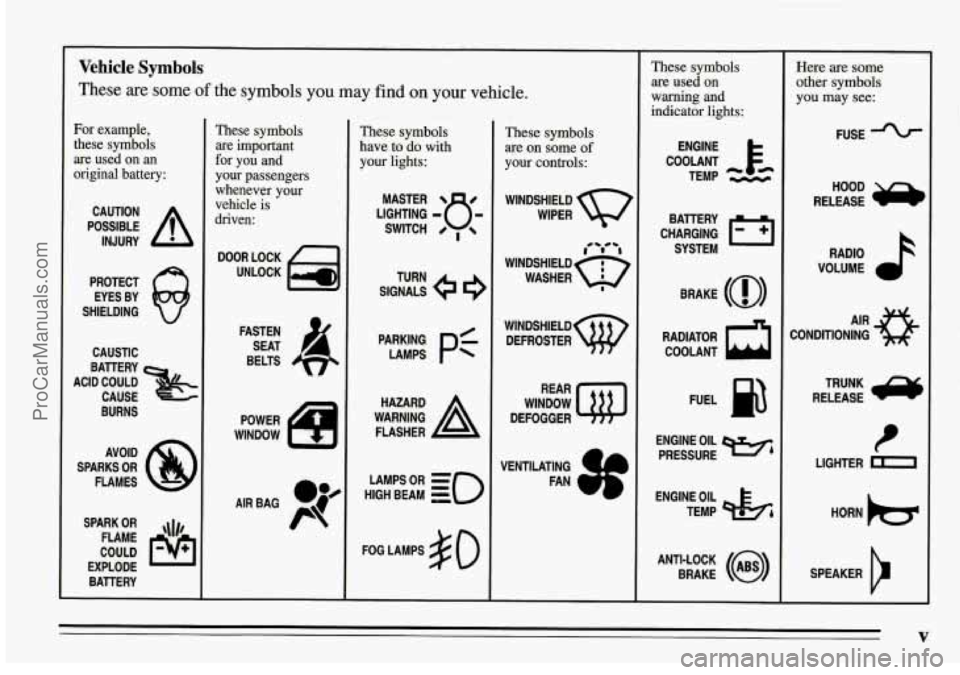
Vehicle Symbols
These are some of the symbols you may find on your vehicle.
For example, these symbols
are used on an
original battery:
POSSIBLE A
CAUTION
INJURY
PROTECT EYES BY
SHIELDING
CAUSTIC
BURNS
AVOID
SPARKS
OR
FLAMES
SPARK OR ,\I/,
COULD FLAME
EXPLODE BAllERY
These symbols
are important
for you and
your passengers
whenever your
vehicle is
driven:
FASTEN SEAT 4
BELTS
POWER
WINDOW
These symbols
have to
do with
your lights:
SIGNALS e
TURN
pAE: pf
HIGH LAMPSoR BEAM = =o
FOG LAMPS $0
These symbols are on some
of
your controls:
WINDSHIELD
WIPER
i ‘t’ i
WINDSHIELD Q
WASHER I
WINDSHIELD
DEFROSTER
WINDOW
DEFOGGER
VENTILATING FAN
These symbols
are used on
warning and
indicator lights:
COOLANT F*
TEMP --
ENGINE
CHARGING 1-1
BATTERY
SYSTEM
BRAKE (0)
RADIATOR COOLANT
a
FUEL
ENGINE OIL
PRESSURE
9%
TEMP OIL &
ANTI-LOCK (a)
BRAKE
-
Here are some
other symbols
you may see:
FUSE
RAM0 h
VOLUME
CONDITIONING AIR 43
RELEASE a
LIGHTER m
SPEAKER
b
V
ProCarManuals.com
Page 60 of 386
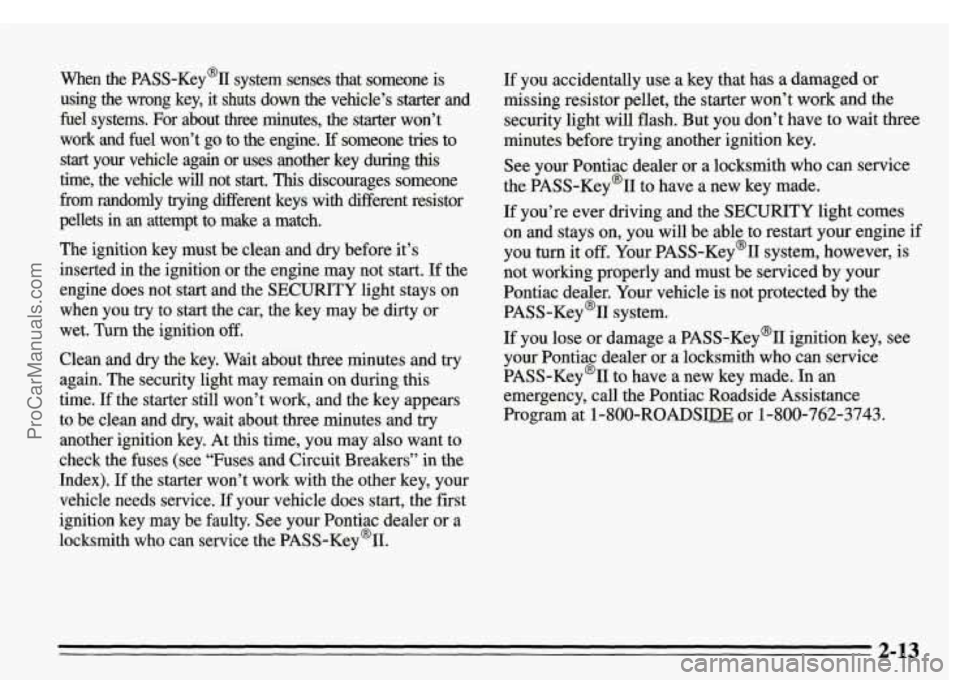
When the PASS-Key(% system senses that someone is
using the wrong key, it shuts down the vehicle’s starter and
fuel systems. For about
three minutes, the starter won’t
work and fuel won’t
go to the engine. If someone tries to
start your vehicle again or uses another key during this
time, the vehicle will not start. This discourages someone
from randomly
trying different keys with different resistor
pellets in
an attempt to make a match.
The ignition key must be clean and dry before it’s
inserted in the ignition or the engine may not start. If the
engine does not start and the
SECURITY light stays on
when you
try to start the car, the key may be dirty or
wet.
Turn the ignition off.
Clean and dry the key. Wait about three minutes and try
again. The security light may remain on during this
time. If the starter still won’t work, and the key appears
to be clean
and dry, wait about three minutes and try
another ignition key. At this time, you may also want to
check the fuses (see “Fuses and Circuit Breakers” in the
Index).
If the starter won’t work with the other key, your
vehicle needs service.
If your vehicle does start, the first
ignition key may be faulty. See your Pontiac dealer or a
locksmith who can service the PASS-Key%.
If you accidentally use a key that has a damaged or
missing resistor pellet, the starter won’t work and the
security light will flash. But you don’t have to wait three
minutes before trying another ignition key.
See your Pontiac dealer or a locksmith who can service
the PASS-Key% to have a new key made.
If you’re ever driving and the
SECURITY light comes
on and stays on, you will be able to restart
your engine if
you
turn it off. Your PASS-Key% system, however, is
not working properly and must be serviced by your
Pontiac dealer. Your vehicle is not protected by the
PASS-Key% system.
If you lose or damage a PASS-Key@II ignition key, see
your Pontiac dealer or a locksmith who can service
PASS-Key’II to have a new key made. In
an
emergency, call the Pontiac Roadside Assistance
Program at 1-800-ROADSIm or
1-800-762-3743.
2-13
ProCarManuals.com
Page 62 of 386

If you have an automatic transmission, the ignition
switch can’t be turned to
LOCK unless the shift lever is
in the PARK (P) position.
OFF (C): Unlocks the steering wheel, ignition and
automatic transmission, but does not send electrical
power to
any accessories. Use this position if your
vehicle must be pushed or towed.
A warning tone will
sound if you open the driver’s door when the ignition is
OFF and the key is in the ignition.
RUN (D): Position to which the switch returns after you
start your engine and release the switch. The switch
stays in the
RUN position when the engine is running.
But even when the engine is not running, you can use
RUN to operate your electrical power accessories and to
display some instrument panel warning and indicator
lights.
START (E): Starts the engine. When the engine starts,
release the key. The ignition switch will return to
RUN
for normal driving.
Note that even if the engine is not running, ACC and
RUN allow you to operate your electrical accessories,
such as the radio and ventilation fan.
Key Release Button: If you have a manual
transmission, your ignition lock has
a key release button.
You must press the button before you can take: your key
out
of the ignition lock.
2-15
ProCarManuals.com
Page 64 of 386

Starting Your Engine
Engines start differently. The 8th digit of your Vehicle
Identification Number
(VIN) shows the code letter or
number for your engine. You will fiid the
VIN at the top
left of your instrument panel. (See “Vehicle
Identification Number”
in the Index.) Follow the proper
steps to start the engine.
Automatic transmission:
Move your shift lever to PARK (P) or NEUTRAL (N).
Your engine won’t start in any other position -- that’s a
safety feature.
To restart when you’re already moving,
use NEUTRAL (N)
only.
NOTICE:
Don’t try to shift to PARK (P) if your Pontiac is
moving. If you do, you could damage the
transmission. Shift to
PARK (P) only when your
vehicle
is stopped.
Manual transmission:
The gear selector should be in neutral. Hold the clutch
pedal to the
floor and start the engine. Your vehicle
won’t
start if the clutch pedal is not all the way down --
that’s a safety feature.
To start your V6 engine:
1. Without pushing the accelerator pedal, turn your
ignition key to START. When the engine starts, let
go of the key. The idle speed
will go down as your‘
engine gets warm.
NOTICE:
Holding your key in START for longer thh
15 seconds at a time will cause your battery to
be drained much sooner. And the excessive. heat
can damage your starter motor.
’ 2-17
ProCarManuals.com
Page 65 of 386
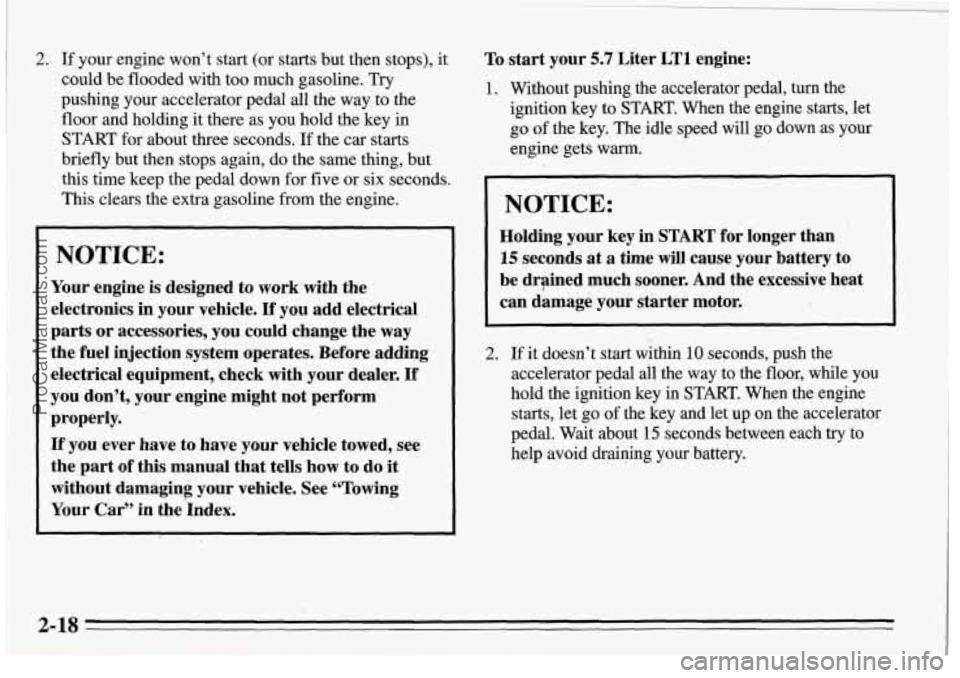
2. If your engine won’t start (or starts but then stops), it
could be flooded with too much gasoline. Try
pushing your accelerator pedal all the way to the
floor and holding it there as you hold the key in
START for about three seconds. If the car starts
briefly but then stops again, do the same thing, but
this time keep the pedal down for five or six seconds.
This clears the extra gasoline from the engine. ~ ~
NOTICE:
Your engine is designed
to work with the
electronics in your vehicle.
If you add electrical
parts or accessories9 you could change the
way
the fuel in&tion system operates. Before adding
electrical equipment, check with your dealer.
If
you don’t, your engine might not perform
properly.
If you ever have to have your vehicle towed, see
the part
of this manual that tells how to do it
without damaging your vehicle. See “Towing
Your Car” in the ‘Index.
To start your 5.7 Liter LT1 engine:
1. Without pushing the accelerator pedal, turn the
ignition key to START. When the engine starts, let
go
of the key. The idle speed will go down as your
engine gets
warm.
I
NOTICE:
Holding your key in START for longer than
15 seconds at a time will cause your battery to
be drained much sooner. And the excessive heat
can damage your starter motor.
2. If it doesn’t start within 10 seconds, push the
accelerator pedal all the way to the floor, while you
hold the ignition key in START. When the engine
starts, let go
of the key and let up on the accelerator
pedal. Wait about
15 seconds between each try to
help avoid draining your battery.
2-18
ProCarManuals.com
Page 66 of 386
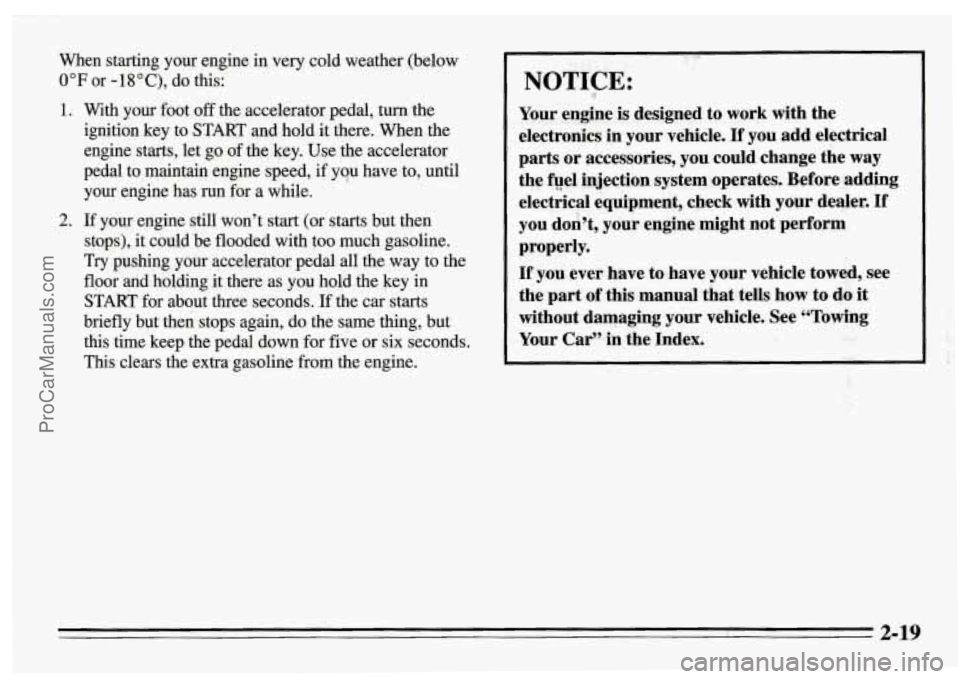
When starting your engine in very cold weather (below
0°F or -18"C), do this:
1. With your foot off the accelerator pedal, turn the
ignition key to START and hold it there. When the
engine starts, let
go of the key. Use the accelerator
pedal to maintaiq engine speed, if you have to, until
your engine has run for
a while.
stops), it could be flooded with too much gasoline.
Try pushing your accelerator pedal all the way to the
floor and holding it there as you hold the key in
START for about three seconds. If the
car starts
briefly but then stops again,
do the same thing, but
this time keep the pedal down for five or six seconds.
This clears the extra gasoline from the engine.
2. If your engine still won't start (or starts but then
' NOTICE:
- Ir
7
Your engine is designed to work with the
electronics in your vehicle.
If you add electrical
parts or accessories, you could change the
way
the fuel injection system operates. Before adding
electrical equipment, check with your dealer.
If
you don't, your engine might not perform
properly.
If you ever have to have your vehicle towed, see
the part of this manual that tells how to do
it
without damaging your vehicle. See "Towing
Your Car" in the Index.
' 4+
2-19
ProCarManuals.com
Page 67 of 386

Driving Through Deep Standing
Water
,*
NOTICE:
If you drive too quickly through deep puddles or
standing water, water can come in through your
engine’s air intake and badly damage your
engine. Never drive through water that is slightly
lower than the underbody
of your vehicle. If you
can’t avoid deep puddles or standing waiter, drive
through them very slowly.
Performance Mode Switch
This switch lets you change from a normal driving mode
to a performance mode. When you start the engine, the
switch will be in normal mode. For general driving
conditions, use
the normal mode. It will remain in
normal unless you select the PERFORM feature.
For a firmer shift and increased performance, you may
choose the
PERFORM mode. The light in the center of
the switch will light
up when selected. The switch will
then remain in performance mode until the engine
is
shut off, when it will go back to normal mode.
ProCarManuals.com
Page 68 of 386
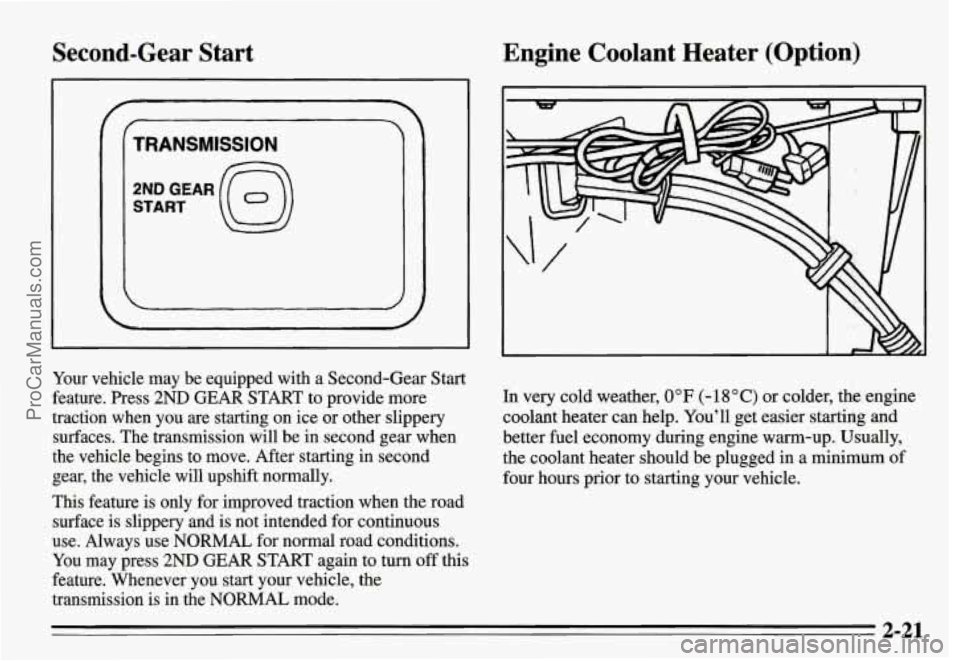
Second-Gear Start Engine Coolant Heater (Option)
TRANSMISSION
2NDGEAR@ START
Your vehicle may be equipped with a Second-Gear Start
feature. Press
2ND GEAR START to provide more
traction when you are starting on ice or other slippery
surfaces. The transmission will be in second gear when
the vehicle begins to move. After starting in second
gear, the vehicle will upshift normally.
This feature is only for improved traction when the road
surface
is slippery and is not intended for continuous
use. Always use NORMAL for normal road conditions.
You may press
2ND GEAR START again to turn off this
feature. Whenever you start your vehicle, the
transmission is
in the NORMAL mode.
In very cold weather, 0 "F (- 18 O C) or colder, the engine
coolant heater can help. You'll get easier starting and
better fuel economy during engine warm-up. Usually,
the coolant heater should be plugged in a minimum of
four hours prior to starting your vehicle.
2-21
ProCarManuals.com
Page 69 of 386

To use the coolant heater:
1. Turn off the engine. NOTICE:
2. Open the hood and unwrap the electrical cord.
3. Plug it into a normal, grounded 110-volt outlet.
2-22
After you’ve used the coolant heater, be sure to
store the cord as it was before to keep
it away
from moving engine parts. If you don’t, it could
be damaged.
I
How long should you keep the coolant heater plugged in? The answer depends on the weather, the kind of oil
you have, and some other things. Instead of trying to list
everything here, we ask that you contact your Pontiac
dealer in the area where you’ll be parking your vehicle.
The dealer can give
you the best advice for that
particular area.
ProCarManuals.com